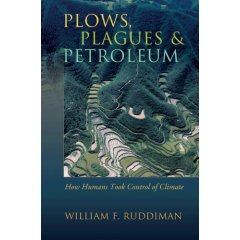
Plows, Plagues and Petroleum, William F Ruddiman, Princeton University Press, 2005, 202pp.
It is by now an established fact that humanity has modified the atmosphere and climate since the beginning of the industrial revolution. However, civilisation has existed for a lot longer than that, fuelled as it was by the beginnings of agriculture. The thesis of William Ruddiman is that we’ve been changing the climate since this time. His new book expands on the ideas currently in the research literature, answering his critics and building a strong case for human induced (anthropogenic) climate change beginning 8000 years ago.
His thesis is simple and compelling – the changes in greenhouse gas concentrations observed in the climatic record cannot be accounted for by natural causes. Greenhouse gases change the temperature of the Earth by absorbing some of the outgoing heat energy that would otherwise escape to space. Changes in the concentration of these gases can be affected by changes in the Earth’s orbit by affecting how much solar radiation reaches the surface of the Earth, and how it is distributed. In particular, changes in heating at the equator affect evaporation and hence rainfall in the tropics (chapter 5). During warmer times, an increase in monsoonal rainfall creates larger wetlands and hence more methane is emitted. Likewise, there is a close (although more complicated) relationship between changes in solar radiation and carbon dioxide. At the end of an ice age (and there have been many throughout Earth’s history, chapter 4), greenhouse gases increase, reaching a maximum at or near the time of minimum ice coverage. After that, their concentration usually slowly decreases as the climate moves slowly towards the next ice age. Yet, the past 10000 years have been kind to humanity. During this period, agriculture, civilisation and all of the worlds major religions appeared (chapter 7).
Now here is the puzzle. During this period, carbon dioxide has increased (from 8000 years ago) and so has methane (5000 years ago). Like a master detective, Ruddiman builds his case that humans are responsible. It is so simple that no doubt many scientists wished they had thought of it. With the advent of rice agriculture (chapter 8), people were making more tropical wetlands to make more methane. Further, domesticated sheep and cattle “emit” methane as does human waste – and agriculture means more food and hence more humans. Carbon dioxide increases are simply understood (chapter 9), they are the result of land clearing for agriculture. Yet, there is a further complication (chapter 11). Ruddiman’s critics claimed that he underestimated the amount of carbon dioxide required. As is often the case, science proceeds in this way – no thesis is accepted first time. The answer is that as humans cleared the land, the warming prevented ice sheets from forming (chapter 10), allowing carbon dioxide to increase (although the details of this are still debated).
Part 4 is intriguing. There are wiggles in the plot of carbon dioxide in the past 2000 years, and these Ruddiman contends, are due to disease. In an age where we worry about bird flu, it is worth remembering that during times of plague, up to 70% of some local populations died out. Forests were quick to grow back, storing carbon dioxide in their woody members.
So what, what does Ruddiman prove? The first thing is that it is very easy for civilisation to impact upon the environment. Even when the worlds population was small, it had a large impact. Now that the world is teems with humanity, it is no surprise that it is struggling to cope with what we have done to it. Secondly, it places what we have done in context. The observed warming in the past 200 years is only half of that observed over 8000 years. Where is the rest? Unfortunately, it is “in the pipeline” as aerosols and the thermal inertia of the oceans. It is a story of tortoise and hare. The tortoise is pre-industrial warming, where the ocean-atmosphere system had a long time to adjust. The hare is the industrial revolution greenhouse emissions, especially since 1970. The Earth is still catching up, and when it does, we are in for trouble (Part 5). In this sense, this book is worth reading even if you don’t have a strong interest in paleoclimatology (as I do).
There are a couple of annoying features of this book. Although not claiming expertise Ruddiman is quick to dismiss the effects of climate on human evolution (p53-4), but doesn’t interact or even name the proponents of this theory. His disclaimer is a smoke screen for some dismissive arrogance. Another is when he comes to address future climate change and politics (epilogue). Whilst it is important to recognise that support for climate change is broad but shallow, and that people wont sacrifice too much for future generations, this doesn’t excuse the US senate for voting down Kyoto. Governments are meant to show leadership. Furthermore, there are changes that can be made that are relatively cheap that will reduce greenhouse emissions. These aren’t discussed as they are in Tim Flannery’s The Weather Makers or Dave Reay’s Climate Change Begins at Home. Neither is it helpful to make climate change secondary to loss of potable water or topsoil, as if these issues were some how separable. They are all part of the same problem. In his desire to appear to be treading the middle ground between environmental and industrial extremists, he undercuts his own arguments.
Aside from these issues, I recommend this book to anyone who wants to be better informed on issues of climate change. It strengthens our concerns and should further motivate us to act to help stabilise not 200 years but 8000 years of inadvertent and culpably knowing climate changes.
No comments:
Post a Comment